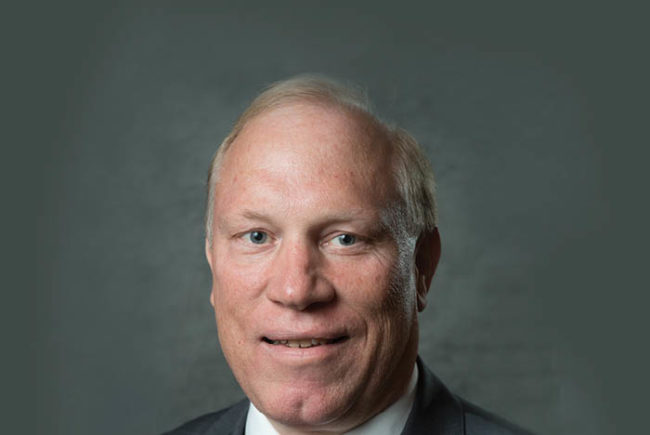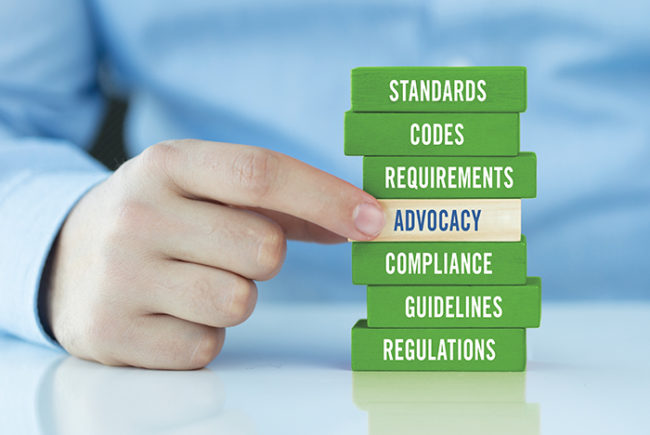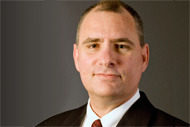
Health care organizations often turn to their accreditation organizations for answers to complex code questions that they can then share with their facilities staff.
Image by Getty Images
Complying with health care physical environment requirements is complex. Testing a facilities professional’s knowledge is a mixture of requirements from the Centers for Medicare & Medicaid Services (CMS) Conditions of Participation or Conditions for Coverage; CMS State Operations Manual; assorted CMS Quality and Safety Oversight memos; National Fire Protection Association (NFPA) codes, standards and guidelines; Occupational Safety and Health Administration requirements; Environmental Protection Agency rules; state and local regulations; and accreditation organizations (AOs), among others.
When health care organizations have questions regarding physical environment requirements, they often turn to their AOs for answers because their AOs are often their most visible authority having jurisdiction (AHJ). These questions range from seemingly simple “yes” or “no” queries to complex questions often requiring extensive research that may include multiple clarifications from the health care organization asking the question.
Sometimes an organization is merely seeking confirmation of its own interpretation of the requirements, while others are looking for detailed answers. While answering questions regarding interpretations is done in a collaborative manner, answers must be provided in a manner that does not cross into consultation. Many answers include a disclaimer that the answer is the opinion and interpretation of the AO and that other AHJs or design professionals may have differing interpretations.
Interesting and complex
Some interesting and complex questions submitted to accreditation organization DNV Healthcare USA Inc. are explored here. Most answers could start with “it depends,” as each question is usually based upon the unique circumstances of the health care organization asking the question. Readers should not assume that answers to any of these questions will specifically apply to situations in their organizations. These exchanges have been edited to ensure anonymity.
• • • • •
There are numerous guidelines and practices recommended by recognized organizations, but how does a hospital decide which practice or standard to follow? The following question juxtaposes hospital regulations and recommended practices.
Question: We currently follow Association of periOperative Registered Nurses (AORN) standards in our operating rooms (ORs). The 2012 edition of NFPA 99, Health Care Facilities Code, 15.13.3.6, instructs that any solution-soaked material has been removed from the room prior to draping and the use of electrosurgery, cautery or a laser. AORN requires solution-soaked material to be a prescribed distance from the patient. How do we resolve discrepancies between nationally recognized standards of practice and NFPA instructions?
Answer: NFPA 99-2012, 15.13.3.6, is a requirement while the AORN standards are recommended practices. From that perspective, the requirement needs to be followed. If the recommendation was stricter than the requirement, then the recommendation could be followed.
This is a prime example of where the CMS process of code adoption or the lack of CMS adopting more current editions of codes conflicts with industry standards. In NFPA 99-2021, the language surrounding flammable-prep soaked materials matches that of the AORN recommendation. However, organizations are required to use NFPA 99-2012. So, until CMS adopts a new edition of NFPA 99 and NFPA 101®, Life Safety Code®, flammable-prep soaked materials will need to be removed from the OR prior to draping.
• • • • •
With the mixture of different AHJs that often regulate a hospital’s construction and facility operations, it is quite common to have conflicts between what CMS requires and what a local AHJ requires. This next question deals with the conflicts between AHJs’ adoption of differing editions of codes.
Question: It says in NFPA 101-2012 to use the 2011 edition of NFPA 25, Standard for the Inspection, Testing, and Maintenance of Water-Based Fire Protection Systems. My question is that my state’s 2020 property maintenance code requires us to use NFPA 25-2017. All of my water-based fire protection reports are coming to me with 2017. Is it ok that my reports say NFPA 25-2017, because that is what my state is asking for?
Answer: In the case where a local or state AHJ requires the use of a code or standard edition that is different than the version adopted by CMS, it is up to the organization to ensure that the most restrictive provisions of the codes are followed. For instance, if a device in the 2017 edition of the code is required to be inspected annually, but the 2011 edition of the code required the device to be inspected quarterly, the quarterly inspection would be required to be documented.
Regardless of the edition of a code or standard adopted by a local or state AHJ, AO surveyors, using CMS adopted codes and standards, will be validating inspection, testing and maintenance against the codes referenced by NFPA 101-2012. It would be the organization’s responsibility to compare the code or standard referenced by the state to the edition referenced by NFPA 101-2012 and ensure that all requirements of the NFPA 101 referenced code or standard are being met or exceeded.
• • • • •
Occasionally, a vendor or contractor will try to convince a hospital that a certain product is suitable for use in the hospital or that a code requires a particular design element. In most cases, vendors and contractors with hospital-specific training are taking the hospital in the right direction. Sometimes, however, the vendor is heading down the wrong path, as illustrated in the following question.
Question: It has been my understanding that spray foam fire block products are not acceptable in health care. A vendor is insisting otherwise. Can you comment please on if this product and products like it would be acceptable for health care use?
Answer: Fire block foams are designed for Type V residential construction, not for commercial firestopping applications. In accordance with NFPA 101-2012, penetrations of fire-rated assemblies must be protected with listed firestop systems or devices. One of the keys is the testing that is listed on the product. Most fire block foams are tested to a modified ASTM E814 standard. The ASTM E814 standard is required of firestop systems. One of the requirements of this test is a hose stream test, but the modified ASTM E814 does not include the hose stream test. As the full ASTM E814 test is not required of fire block foams, fire block foams do not qualify as firestop systems.
Additionally, and often easier than dealing with the nuances of the listing and testing of the products, the label materials for fire block foams or the technical data sheets for the products state that they are not firestopping sealants or some similar language. For example, the technical bulletin for the fire block foam attached to your question states “Not for commercial/industrial code applications. Not for E-814 applications or assemblies (i.e., not for one/two-hour fire-rated walls and floors). Not a fire stopping sealant.”
All manufacturers of approved firestop systems include detailed UL-listed firestop system drawings and instructions on the use of the firestop product with details such as the barrier type, construction details of the barrier, the type(s) of penetrating items allowed, any backing material needed, the proper application of firestop sealants (e.g., depth and annular space) and the allowable products to be used. The fire block foams do not have such approved firestop system drawings associated with them.
• • • • •
The nuances of regulations for electrical systems and emergency power can be complex. Often, hospitals must comply with the requirements of NFPA 99-2012; the 2010 edition of NFPA 110, Standard for Emergency and Standby Power Systems; and the 2011 edition of NFPA 70®, National Electrical Code®. The following question-and-answer exchange highlights this complexity.
Question: What is the frequency for testing the batteries on the generators? We have been testing them each month during the load test instead of during the weekly test. Is this acceptable?
Answer: Inspection, testing and maintenance of generator batteries is covered by NFPA 110 and any applicable manufacturer’s instructions. While I am unable to address the specifics of any manufacturer’s instructions, the manufacturer’s instruction must be followed in addition to any NFPA 110 requirements.
From the perspective of NFPA 110-2010, there are weekly inspecting requirements and monthly testing requirements. The batteries must be inspected weekly. The only specifics given are that electrolyte levels must be checked weekly for traditional lead-acid batteries, and voltage must be checked weekly for both lead acid and sealed batteries, with the voltage being within the manufacturer’s specifications. Monthly required testing of batteries includes monthly testing and recording of electrolyte specific gravity; for sealed batteries, battery conductance testing can be performed in lieu of specific gravity testing.
• • • • •
The use of relocatable power taps (RPTs) or power strips in hospitals has been the subject of much discussion over the years. In NFPA 99-1999, RPTs described as two or more power receptacles supplied by a flexible cord were only permitted to be used in anesthetizing locations to supply power to plug-connected components of a movable assembly, such as a rack, cart or table, with specific requirements for mounting and ampacity; they were not to be used in other patient care areas. In 2014, CMS published a categorical waiver that allowed for the expanded use of RPTs, based on the requirements of NFPA 99-2012. When CMS adopted NFPA 99-2012, there was no longer a need for the categorical waiver as the 2012 edition codified the requirements for RPTs. However, the following question and answer shows there is still confusion in the field.
Question: Can we use an outlet extender on an outlet out of the patient vicinity for non-patient care items in a patient care room? Or must it be an RPT UL 1363?
Answer: I am unsure what you mean by “outlet extender,” but I will attempt to answer your question using NFPA 99-2012 references for electrical equipment in the hospital.
A patient care vicinity is defined as a space within a location intended for the examination and treatment of patients (i.e., patient care room) extending 6 feet beyond the normal location of the bed, chair, table, treadmill or other device that supports the patient during examination and treatment and extending vertically 7 feet, 6 inches above the floor.
Per guidance from CMS, and in compliance with the requirements of NFPA 99-2012, the RPTs, powering rack, table, pedestal or cart-mounted patient care- related equipment are permitted in the patient care vicinity if the RPTs are listed as UL 1363A or UL 60601-1; the RPTs are permanently mounted to the equipment; the total ampacity of the equipment plugged into an RPT does not exceed 75% of the ampacity of the flexible cord supplying the RPT; means are taken to ensure additional devices or nonmedical equipment cannot be connected to the RPT after leakage currents have been verified as safe; and the electrical and mechanical integrity of the RPT is regularly verified and documented.
RPTs, regardless of their UL listing, may not be used to power non-patient care-related equipment when located in the patient care vicinity. RPTs used outside of the patient care vicinity, including in the patient care room, powering non-patient care equipment would need to be UL 1363 listed and be used in accordance with their instructions for use.
If by “outlet extender” you are referring to an extension cord, per NFPA 70-2011, they are only permitted for temporary use, such as plugging in a tool on an as-needed basis, and cannot be used as a substitute for permanent wiring. For example, using an extension cord because there are not enough receptacles or they are not conveniently located in a room would not be permitted.
• • • • •
The NFPA 99-2012 requirements for battery-powered lighting units for locations where deep sedation and general anesthesia are administered often bring up questions. One of the first things a surveyor needs to confirm when examining a location for battery-powered lighting units is that the definitions of deep sedation and general anesthesia used by the hospital match the definitions given in NFPA 99-2012. Often, questions include nuances that require one to go outside of Chapter 6 of the code, as noted in the following.
Question: I have a question regarding the requirement for battery-powered lighting in areas where deep sedation and general anesthesia are administered. We are looking to define areas where the code (NFPA 99-2012, 6.3.2.2.11) applies, and there has been some difficulty. In areas where planned procedures do not take place but have a higher probability of administering anesthesia (e.g., an intensive care unit and a crowded emergency room), would we be required to install battery-powered lighting? We recognize that we have procedure rooms (e.g., catheterization labs, trauma rooms and endoscopy rooms) where these lights would be required and are installed but are looking for guidance on the aforementioned areas due to the potential impact to our budget and planning required to work in these high-acuity areas. The common consensus has been that we do not need them in non-procedure spaces as we would only do unplanned sedation (NFPA 99-2012, 1.3.3.1, 1.3.3.2).
Answer: From a pure code language perspective, the battery-powered lighting is required in any location where deep sedation and general anesthesia are administered. The code itself makes no reference as to whether deep sedation and general anesthesia were planned for the location when constructed. From a practical perspective, we interpret the requirement as being for locations where deep sedation and general anesthesia were planned. Another factor going into our interpretation is that deep sedation and general anesthesia could occur anywhere in an emergency, with 1.3.3.1 and 1.3.3.2 covering those instances.
Evaluating the need for battery-powered lighting does not end with having the policy required by NFPA 99-2012, 1.3.3.1. The documentation of each use of a location that does not comply with the code requirements (NFPA 99-2012, 1.3.3.2) is intended to reduce the use of non-compliant spaces. Cognizant with the International Organization for Standardization’s ISO 9001 principles, the uses of non-compliant spaces are to be documented and reviewed. This review should be an analysis of the use of non-compliant spaces to examine trends and determine if, in this case, battery-powered lighting should be added to a location.
• • • • •
Egress issues are common in almost all occupancies. While there are many allowances in NFPA 101-2012 for locking doors in the path of egress in specific situations, all the allowed locking arrangements have very specific requirements. One of the more complex sets of requirements concern the locking of egress doors where patients’ special needs require protective measures for their safety, as illustrated in the following exchange.
Question: We have a labor and delivery unit with stairwells that are locked against egress but that unlock upon fire alarm activation. We have heard that we also need to have a means to unlock the door remotely. Is that true?
Answer: Door locking arrangements for units such as labor and delivery are covered by NFPA 101-2012, 19.2.2.2.5.2 (Chapter 18 has the same requirements for new construction). We have seen that many organizations do not have compliant locking arrangements in these types of units; often the installation predated the 2016 adoption of NFPA 101-2012. In retrospect, the locking arrangements of NFPA 101-2012, 19.2.2.2.5.2, were not permitted by NFPA 101-2000, even though many local AHJs approved of the installations, many of which released on fire alarm.
For a compliant locking arrangement of a labor and delivery unit’s egress, all of the requirements of 19.2.2.2.5.2, which also includes 19.2.2.2.6, need to be met. These requirements include, from 19.2.2.2.6, that all staff be able to readily unlock the doors by use of a key always carried by staff, remote control of the locks or by other reliable means such as keypads or a badge reader; 19.2.2.2.5.2 additionally requires the following to be met: a total smoke detection system is provided throughout the locked space or the locked doors can be remotely unlocked from a constantly attended location within the locked space, the building is fully sprinklered, the locks are electrical that fail-safe upon power loss, and the locks release by activation of the smoke detection system installed in the space and upon waterflow of the fire sprinkler system.
In the majority of situations, when there is a nonconformance related to this locking arrangement, it is the requirement under 19.2.2.2.5.2(2) that “a total (complete) smoke detection system be provided throughout the locked space in accordance with 9.6.2.9, or locked doors can be remotely unlocked at an approved, constantly attended location within the locked space” that is not being met. Very few facilities with fire sprinklers have complete (total) smoke detection installed, so the means to unlock the doors from a constantly attended location within the locked space would be required.
Understanding the ‘why’
As can be seen from this sampling, the questions vary from straightforward to convoluted, but the goal in answering a question is not to simply give a “yes” or “no” answer, but to give an answer that allows the questioner to understand the “why” and rationale for the answer.
Professionals should be sure to use all of their resources when seeking answers. In addition to an AO, many AHJs are willing to field questions, and resources such as the My ASHE community (my.ashe.org) as well as state and local health care engineering groups are helpful.
An overview of DNV Healthcare
DNV Healthcare USA Inc. is part of an international accredited registrar and classification society headquartered in Oslo, Norway, with additional support offices in Katy, Texas, and Cincinnati. The company currently has about 12,000 employees and 350 offices operating in more than 100 countries and provides services for several industries including maritime, oil and gas, renewable energy, electrification, food and beverage, and health care.
In 2008, when DNV received deeming authority from the Centers for Medicare & Medicaid Services (CMS) to accredit health care facilities in the U.S., it forever changed how health care accreditation is performed. Instead of making one-time, short-term corrections after a finding from a survey, the DNV approach allows health care organizations to develop their own processes that comply with the CMS-approved DNV NIAHO® (National Integrated Accreditation for Healthcare Organizations) accreditation standards to focus on long-term sustainable preventive action processes to mitigate and minimize adverse and sentinel patient events.
Over the past 15 years, DNV Healthcare has grown to become the second-largest hospital accreditation organization in the U.S. Its scope of services includes the accreditation of acute care, critical access and psychiatric hospitals. It also provides certification services for four levels of stroke and several other certifications. DNV anticipates final approval from CMS to accredit ambulatory surgical centers in late 2023 or early 2024.
DNV surveys are not a pass/fail test. There are no traditional scoring systems and no tipping points. Errors happen once; twice is a coincidence; and three times is a pattern. There are exceptions, but, for the most part, this is how DNV Healthcare surveyors evaluate the effectiveness of the process approach.
Successful accreditation of a health care organization is not based solely on the volume and type of nonconformities (i.e., findings) identified but on the successful implementation of sustainable corrective action processes to emphasize continual improvement and to prevent the recurrence of similar nonconformities in the future.
Clinton Butts, CFPS, CHOP, is standards application and interpretation specialist for health care accreditation services at DNV Healthcare USA Inc. He can be reached at clinton.butts@dnv.com.





